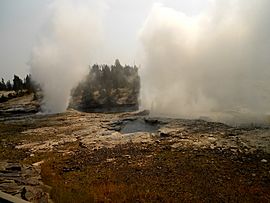Fan and Mortar Geysers facts for kids
Quick facts for kids Fan and Mortar Geysers |
|
|---|---|

Mortar Geyser is on the left, and Fan Geyser is on the right.
|
|
| Name origin | Fan - Washburn Party (1870) Mortar - Frank Jay Haynes (1883) |
| Coordinates | 44°28′28″N 110°50′33″W / 44.47444°N 110.84250°W |
| Elevation | 7,300 feet (2,200 m) |
| Type | Cone geyser |
| Eruption height | Fan-125 feet, Mortar 80 feet |
| Frequency | 3 days-weeks |
| Duration | 30 min |
| Temperature | 48.2 °C (118.8 °F) |
Fan and Mortar Geysers are two amazing geysers found in the Upper Geyser Basin of Yellowstone National Park. For many years, these two geysers have erupted together. When one goes off, the other usually does too! They are known for erupting rarely and not on a regular schedule.
Contents
History of Fan and Mortar Geysers
The large size of Fan and Mortar Geysers shows they were very active a long time ago. Before 1925, they were just two separate geysers. They erupted on their own and were not as powerful as they are today.
Sometime before 1925, the two geysers must have connected deep underground. Since then, they have erupted as one very large geyser. The Fan Geyser got its name from the Washburn–Langford–Doane Expedition in 1870. The Mortar Geyser was named by Frank Jay Haynes in 1883. He thought its eruptions looked like a mortar firing.
Where to Find Fan and Mortar Geysers
These two geysers are located right next to the Firehole River. You can easily see Fan and Mortar Geysers from the bridge. They are also visible from the sidewalk that goes north towards Morning Glory Pool. This area is just a little north of the Riverside Geyser.
What Do Fan and Mortar Geysers Look Like?
Fan and Mortar Geysers are on the same side of the Firehole River as the viewing area. This is different from Riverside Geyser, which is across the river.
Mortar Geyser is the large, cone-shaped geyser on the left. It has a main opening called Upper Mortar. Below it is another opening called Lower Mortar. There is also a smaller opening to the left of Lower Mortar.
Fan Geyser has at least seven openings. These openings are lined up roughly sideways to the river. Starting closest to the river, they are: River Vent(s), High Vent, Gold Vent, Gold 2, Angle Vent, Main Vent, and East Vent. Many other smaller openings are scattered around the area. There is also another geyser nearby called Spiteful Geyser, which is close to the boardwalk.
How Fan and Mortar Geysers Erupt
These geysers usually follow a series of smaller activities before a big eruption. This cycle often happens like this:
- All the openings in the system are quiet.
- The River vent starts to flow. (If it stops before the Angle vent starts, it's called a "river pause.")
- The High vent starts to flow.
- The Gold vent starts to flow. (If this and other vents stop before the Angle vent starts, it's called a "gold pause.")
- The Angle vent starts to flow. (The cycle is complete when Angle comes on.)
During an eruption cycle, the above steps usually happen. You might also see splashing in the Main vent. Sometimes, the Bottom vent might even erupt. After all the vents mentioned above turn on, if the High and Gold vents start erupting steadily to 5 feet or more, it's called a "lock." Usually, Fan and Mortar will erupt soon after a lock, but it's not always certain.
The geysers typically erupt after this cycle is complete. However, some eruptions have started with Lower Mortar, and even more rarely, with Upper Mortar. Before an eruption, the water levels in the whole area usually rise. But remember, the geysers can erupt at any time!
When they erupt, the geysers become more powerful. The water level in the complex rises. Splashing in the river and main vents increases. Sometimes, a huge surge from the East vent can trigger the eruption. All the openings in Fan Geyser will constantly shoot out water. The Angle vent can launch water all the way to the boardwalk, and sometimes even past it.
Fan Geyser truly lives up to its name. It erupts from all seven of its openings. This creates a wide, fan-shaped jet of water. This jet can reach heights of over 100 feet! It arcs water over the boardwalk, landing 200 feet away from the opening. Mortar Geyser is not as spectacular as Fan, but it still sends jets of water up to 50 feet high from its two main openings. Sometimes, one opening will shoot water over 80 feet into the air!
The eruption usually lasts about 15 minutes. Then it stops, but restarts again, losing some power each time. This happens a few more times, until about 45 minutes have passed. After that, it might enter a short steam phase. During this phase, the geysers send brief puffs of steam from their openings.

